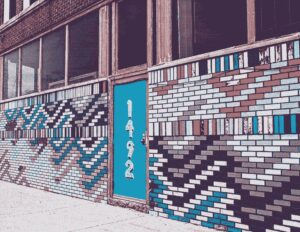Lesson Ideas
Exploring The Role of Early Detroit Techno Labels
Students should explore the article below and the discussion guide. Learn more by watching the video and exploring the locations contained in the article. Use the info to answer the Essential Questions below in a discussion with your students.
Learning Objectives:
- Explore the locations where the first Techno Labels were
- Determine what is the role of the record label
- Compare how music was distributed in the past with how it is distributed now.
 The emergence of techno occurred in Detroit in the late 1980’s. Techno Boulevard is located near Eastern Market on the intersection of Gratiot and Russell St. It housed famous record labels and studios such as Juan Atkin’s Metroplex, Kevin Saunderson’s KMS, and Derrick May’s Transmat. They were also known as “the Belleville Three” due to their proximity to one another growing up. Techno Boulevard allowed them to continue to collaborate and it became an incubator that allowed DJs to continue to learn from one another and fine-tune their skills by remixing each other’s material. Furthermore, since digital recording techniques were not common and most of the recordings were put on reel-to-reel tape, it helped with the time-consuming job of editing tape for labels to be close together so that they could share resources. “…as young inspiring DJs were only too happy to perform as it meant becoming part of the process—and sometimes even getting small credits on a label.” (Dan Sicko, 55). It was also advantageous because it enabled booking agents, promoters, and other industry professionals to touch base with multiple labels at the same time when they came to town.
The emergence of techno occurred in Detroit in the late 1980’s. Techno Boulevard is located near Eastern Market on the intersection of Gratiot and Russell St. It housed famous record labels and studios such as Juan Atkin’s Metroplex, Kevin Saunderson’s KMS, and Derrick May’s Transmat. They were also known as “the Belleville Three” due to their proximity to one another growing up. Techno Boulevard allowed them to continue to collaborate and it became an incubator that allowed DJs to continue to learn from one another and fine-tune their skills by remixing each other’s material. Furthermore, since digital recording techniques were not common and most of the recordings were put on reel-to-reel tape, it helped with the time-consuming job of editing tape for labels to be close together so that they could share resources. “…as young inspiring DJs were only too happy to perform as it meant becoming part of the process—and sometimes even getting small credits on a label.” (Dan Sicko, 55). It was also advantageous because it enabled booking agents, promoters, and other industry professionals to touch base with multiple labels at the same time when they came to town.
Explore the locations and the readings (see links below) to understand the history of music industry communities during the early evolution of the music industry in the US.
Early on in music publishing history, the need for sheet music creators to be in close proximity to piano factories, and Vaudeville stages resulted in a section of Manhattan, NY called Tin Pan Alley, and later in history coalesced again in the music creation done in the Brill Building. The music publishing industry started in Tin Pan Alley (20’s) and The Brill Building (30s-60s) in NYC and spread across the country to locations like “Hitsville USA” in Detroit defined R&B/Soul and “Record Row” in Chicago (50s-60s) defined The Blues and Soul.
Student Activities
- Research the roles of early publishers and distributors in the development of musical art forms. Write a profile on a publisher who “discovered” an artist that is important to you.
- Students discuss why (at that time Techno was born) having labels close to one another could be beneficial to a new genre, culture, and community. Compare and contrast other locations important to the growth of different musical genres around the world.
In Detroit, this need for the key components in the music industry to be in close proximity in Detroit originally manifested in the Motown legacy but was replicated later in what is now called “Techno Boulevard” (the 80s-90s). Use the links below to learn more about Techno Blvd and its role in the creation of Techno.
- Metroplex and Transmat Records Were Once On Techno Boulevard
- KMS Records Was Once on Techno Boulevard
Essential Questions:
- What is the role of a Publisher or Distributor? Why is distribution such an important part of the music industry?
- Why was it advantageous for early artists and people in the publishing industry to work in the same area?
- Why is collaboration important in music production?
- How was Tin Pan Alley similar to or different than “Techno Boulevard”


